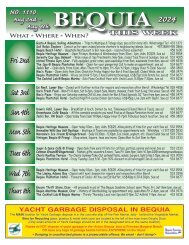Caribbean Compass Yachting Magazine - April 2021
Welcome to Caribbean Compass, the most widely-read boating publication in the Caribbean! THE MOST NEWS YOU CAN USE - feature articles on cruising destinations, regattas, environment, events...
Welcome to Caribbean Compass, the most widely-read boating publication in the Caribbean! THE MOST NEWS YOU CAN USE - feature articles on cruising destinations, regattas, environment, events...
You also want an ePaper? Increase the reach of your titles
YUMPU automatically turns print PDFs into web optimized ePapers that Google loves.
Today, we can purchase packaged cassava flatbread<br />
in shops and markets. It’s a handy and long-lasting<br />
galley item.<br />
LOTSA CASSAVA!<br />
by JoAnne & Bill Harris<br />
Important note<br />
Cassava must be properly prepared before eating; it<br />
cannot be eaten raw. All parts of the plant contain<br />
cyanogenic glycosides. This can result in fatal cyanide<br />
poisoning if the leaves are not boiled and the tubers are<br />
not properly detoxified by peeling, pounding, soaking,<br />
cooking, grating and wringing, and/or drying before<br />
being consumed. However, acute cassava-associated<br />
cyanide poisoning outbreaks are extremely rare.<br />
Ask market vendors if their cassava is “sweet” or<br />
“bitter” (bitter has more cyanogenic glycosides), and<br />
ask them for safe preparation tips.<br />
First taste of cassava<br />
We always are great sports at trying new foods at the<br />
places we visit. The first time we ever tasted cassava<br />
bread — a crispy cracker-like flatbread — was on the<br />
island of Dominica during our first island tour with<br />
our local friend, Martin Carriere of Providence. He took<br />
us on a great adventure all around the island and to<br />
the most intriguing part — the Carib community. We<br />
purchased two enormous cassava breads hot off of the<br />
griddle. They were dry, but delicious since they had<br />
been infused with grated coconut. Cassava bread is a<br />
traditional bread originally made by the Arawak<br />
peoples from South America and the <strong>Caribbean</strong>. It<br />
predates European contact by several centuries.<br />
We have also tried another type of cassava bread, a<br />
delicious Brazilian loaf made by our Brazilian friends<br />
Peter, Elena and Arthur aboard S/V Pura Vida during<br />
fun times anchored beside them in the atolls of Belize.<br />
(See recipe below.)<br />
Funny cassava story<br />
Several years ago we sailed into Ile-à-Vache, Haiti,<br />
where we stayed for two weeks to wait for a weather<br />
window. We toured the island with a group of<br />
charming children who were our guides. To pay for<br />
Preparing cassava for use involves peeling off the<br />
brown outer skin and then washing away the dirt<br />
before boiling or grating.<br />
CHIDINMA0025<br />
and chewy.) Drain, mash and mix with green onion,<br />
salt and pepper. Remove any hard fibrous bits. Shape<br />
into four or five patties with oiled hands. Set aside.<br />
Heat oil in a small pan and add diced onion. Cover<br />
and cook over medium heat three or four minutes<br />
until softened. Fry patties until golden brown. Remove<br />
and drain on a paper towel. Garnish with fresh<br />
cilantro and lime wedges. Serve with spicy hot sauce.<br />
Native to the tropical New World, cassava has long<br />
been a staple. Here Taíno women are depicted<br />
preparing cassava bread in 1565: grating yuca roots<br />
into paste, shaping the bread, and cooking it on a fireheated<br />
burén.<br />
Ultra’s Yuca Cake<br />
4 Cups mashed cooked yuca<br />
2 Cups sugar<br />
2 1/2 Cups coconut milk<br />
1/4 Cup coconut oil<br />
1 1/2 teaspoons ground cinnamon<br />
1 1/2 teaspoons grated nutmeg<br />
4 Tablespoons vanilla<br />
1 teaspoon salt<br />
Preheat oven to 350°F.<br />
Peel and chop yuca. Boil until tender, drain, and<br />
remove all fibrous bits. Blend yuca in a food processor<br />
until smooth or hand mash.<br />
Add sugar, coconut milk, coconut oil, cinnamon,<br />
nutmeg, vanilla, and salt.<br />
Pour into greased pan and bake for 1 1/2 to 2 hours.<br />
Please note: The yuca cake will have a yummy<br />
pudding-like texture you will love.<br />
Pura Vida Pao de Yuca (Yuca Bread)<br />
1 Cup boiled, drained, and mashed yuca<br />
3 1/2 Cups white flour<br />
1/2 teaspoon salt<br />
1 teaspoon sugar<br />
4 Tablespoons olive oil<br />
2 1/2 teaspoons dry bread yeast<br />
1 3/4 Cups warm water<br />
In a deep bowl place ingredients one by one and mix<br />
them together. Gradually add the warm water while<br />
kneading the dough. It will not form a ball like other<br />
bread dough. It will be wet — you will know the correct<br />
consistency when it does not stick to your palm when<br />
you gently press it.<br />
APRIL <strong>2021</strong> CARIBBEAN COMPASS PAGE 31<br />
We have been cruising full time for more than 13<br />
years now. We’ve encountered all sorts of new food<br />
adventures and enjoyed experimenting by making<br />
heaps of local recipes from local ingredients throughout<br />
our global travels. Cassava is one of them.<br />
All about cassava<br />
Tapioca pudding is one of Bill’s favorites from his<br />
days as a child living in Southern California. We<br />
learned this fave was derived from the starch extracted<br />
from the cassava root.<br />
Cassava (Manihot esculenta) is a perennial woody shrub<br />
with an edible starchy root that is often made into flour.<br />
The root, or tuber, is about eight inches long and has a<br />
brown, fibrous skin and snowy white or yellowish interior<br />
flesh. It grows in tropical and subtropical areas of the<br />
world. Resistant to drought, diseases, and pests, and<br />
tolerant of poor soils, it is a major source of carbohydrates<br />
in tropical areas. Cassava is a fat-free and gluten-free,<br />
and higher in fiber and potassium than potatoes.<br />
Other names for cassava are manioc, mandioca,<br />
casaba, and tapioca. In Latin America it’s often known<br />
as yuca, pronounced yoo-kuh, not to be confused with<br />
the yucca, the spiky ornamental plant that you<br />
probably had in your first flat.<br />
The plant is native to Central and South America<br />
and its root is commonly incorporated into a variety of<br />
Latin American dishes. It is also a popular staple in<br />
Africa, Southeast Asia and throughout the <strong>Caribbean</strong>.<br />
In the Eastern <strong>Caribbean</strong> it is most commonly eaten<br />
boiled as a starchy vegetable, or grated and then<br />
roasted to make a crunchy flour called “farine,” or<br />
ground into flour used in breads and desserts.<br />
their school uniforms and tuition, they wished to help<br />
us polish our trimaran, Ultra, until she was sparkling.<br />
We served lunch to them every day they worked. The<br />
first day we did not have much in the galley to quickly<br />
offer them. We had been to the African Market the day<br />
before, and we had purchased a large fresh cassava<br />
flatbread. JoAnne spread peanut butter on it and<br />
served it up. The children were hungry and the<br />
impromptu meal quickly disappeared. Soon JoAnne<br />
heard coughing and the children saying in unison,<br />
“Eau, eau, s’il vu plait!” Note to self, cassava bread can<br />
be thick and dry and serving this with peanut butter<br />
increases these traits exponentially. Several glasses of<br />
water coming right up.<br />
Here are some yummy recipes we’ve learned since<br />
that will go down a lot better!<br />
Cassava Fritters<br />
1 pound yuca root<br />
2 green onions, chopped<br />
salt to taste<br />
1/4 teaspoon ground black pepper<br />
1/2 teaspoon cooking oil (for oiling hands)<br />
2 Tablespoons oil for cooking (coconut oil preferred)<br />
1 Cup diced onion<br />
Chopped fresh cilantro<br />
Lime wedges<br />
Salsa or pepper sauce<br />
Peel the yuca and cut into two-inch slices. Cover<br />
with water and boil about 20 to 30 minutes until soft.<br />
(When raw the flesh is white, but when cooked it turns<br />
yellow and is slightly translucent, and a little sweet<br />
Our friends aboard S/V Pura Vida taught us how to<br />
make this Brazilian cassava loaf.<br />
Let stand covered with a cloth in a greased bowl in a<br />
warm place until doubled in size. Place in a greased<br />
loaf pan. Bake at 375°F for 45 minutes.<br />
Enjoy!

















